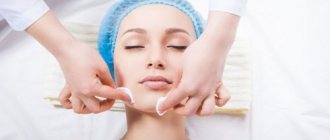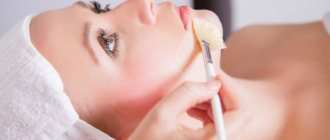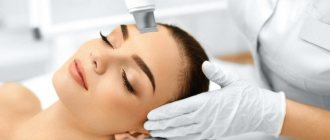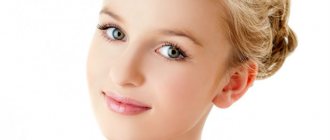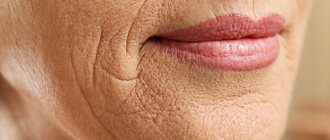Many modern women prefer to combine peeling and biorevitalization, since together these procedures have a pronounced rejuvenating effect. This combination is beneficial for skin of any age, but most often cosmetologists recommend it to patients after 35 years of age, because skin aging processes accelerate from this age.
In order not to cause harm to the skin instead of benefit, you should know how long after biorevitalization you can go for hair removal.
What comes first – peeling or biorevitalization
To understand how to alternate sessions, you need to imagine how both cosmetic procedures act on the skin.
Peeling is a type of cleansing through which the middle and deep layers of the skin are freed from dirt and fat accumulations. As a result, the likelihood of inflammatory formations decreases, metabolism improves, the skin breathes easier, and rejuvenates.
Epilation is a stressful factor. Aggressive substances have a destructive effect on the superficial keratinized skin cells, after which the process of tissue restoration begins, and collagen and elastin fibers begin to be actively synthesized. New skin becomes more resistant to adverse external factors.
Peeling is offered in beauty salons:
- acidic (based on organic acids);
- hardware (ultrasonic, laser);
- scrubbing;
- applying masks based on fruit acids.
Biorevitalization is a new cosmetology service that is becoming increasingly popular. It involves injections of hyaluronic acid into the deep layers of the skin. The drug has a gel-like consistency and easily penetrates the skin, does not cause irritation, and is not rejected.
Due to the introduction of hyaluronic acid:
- the supply of skin tissue with moisture improves;
- hormonal synthesis increases in skin cells;
- the surface of the skin becomes smooth and tightened;
- metabolism is normalized, tissues receive enough nutrition;
- the skin acquires a pleasant even tone.
To achieve a positive result, you must complete a course of several sessions of hyaluronic acid injections. Visible changes are noted after 2 procedures.
Combining peeling and biorevitalization is allowed, but not on the same day. With complex influence, the positive effect doubles. Moreover, let’s say peeling after biorevitalization, and vice versa.
When choosing peeling or biorevitalization, the patient should take into account that the procedures are differentiated by age categories. So, it is even given to teenage girls who, due to hormonal changes, have acne and other unpleasant formations.
And biorevitalization is recommended for women after 30-35 years. There is no need for young girls to undergo biorevitalizing peeling, because due to their age they already synthesize enough hyaluronic acid.
Expert opinion
Elena Apostolyuk
Cosmetologist
It is advisable to carry out peeling before biorevitalization. After deep cleansing, hyaluronic acid penetrates better into the skin tissue, reduces swelling of the treated tissue, and gives a pronounced rejuvenation effect.
When alternating the two procedures, external and internal positive changes are noted:
- cells receive a sufficient amount of moisture, dryness and flaking are eliminated;
- skin tissues are strengthened, tightened, more elastic, softer;
- the synthesis of your own collagen and elastin is accelerated;
- the old superficial skin layer with dead cells is removed;
- cellular respiration improves;
- wrinkles and pigment formations are eliminated;
- complexion becomes healthy and beautiful.
The essence of the procedures
To understand whether peeling is necessary before biorevitalization, it is first advisable to understand the specifics of both procedures. They are very popular among the fair sex who care about their appearance.
Using these techniques, you can effectively rejuvenate and tighten the skin, cleanse it, and make it more hydrated. You will achieve better results if you carry out these procedures regularly. But you should not abuse them, ignoring the recommendations of specialists.
Peeling
During this procedure, no substances are injected under the patient's skin. Peeling improves local metabolism by removing dead cells. After it only the healthy and young remain.
Skin renews itself throughout a person's life. As the epidermis gets older, this process slows down - dead cells are separated much less easily.
Sometimes the “spent” layer remains on the surface for a long time and interferes with the penetration of nutrients and tissue respiration. In order for the skin to function normally, it is necessary to stimulate natural metabolism, removing dead cells in a timely manner.
Acid peeling is one of the most effective procedures. When carrying out such cleaning, special preparations are used. These products are quite concentrated, so they are not recommended for use at home. It is better to entrust acid peeling to an experienced cosmetologist.
Biorevitalization
This procedure involves the introduction of hyaluronic acid into the skin. This substance is part of the skin, blood, lymph, therefore it is absolutely safe. To transport it into the dermis and epidermis, laser devices or injections are used.
Hyaluronic acid takes root remarkably well, is not rejected by the human body and provides the following beneficial effects:
- saturating the skin with elements that are necessary for its normal functioning (minerals, vitamins, etc.);
- improvement of metabolic processes;
- acceleration of elastin and collagen production;
- deep hydration, moisture retention.
To achieve better results, you need a course of such procedures. A professional can determine their number. He will take into account the presence of contraindications and indications, the woman’s age, and the condition of the skin.
Combination
It is strictly forbidden to carry out peeling and biorevitalization at the same time. Both procedures are characterized by a high degree of trauma. Biorevitalization is allowed after peeling only when the rehabilitation period is completed. Otherwise, serious complications cannot be avoided.
Conditions for combining procedures:
- The duration of the pause between sessions is set by the cosmetologist. The skin must recover from the aggressive effects of cleansing agents.
- Biorevitalization after peeling is more desirable. But whatever the combination of procedures, their effectiveness increases almost 2 times with a complex effect.
- With comprehensive care, fewer sessions are required. 2 peeling sessions and 3 biorevitalization sessions are enough, which is beneficial both financially and time-wise.
How long after one procedure to do another is determined by the cosmetologist, focusing on the individual characteristics of the patient’s skin. Typically, experts advise performing it 2 weeks after chemical peeling. And if retinoic acid was used, then after peeling you can do biorevitalization within 4-5 days.
The main thing about peeling with hyaluronic acid
| Type of peeling | chemical |
| Peeling type | surface |
| Skin type | oily, normal, dry |
| Active substance | hyaluronic acid |
| Pre-peeling preparation | desirable |
| Post-peeling care | required within 10 days |
| Contraindications | There is |
| Price of one procedure in the salon | from 700 rubles |
| Number of sessions | 3-10 procedures, selected individually |
| Home procedure | possible |
| Seasonality | can be done all year round |
| Analogs (superficial chemical peels) | ascorbic peeling wine peeling glucone peeling aspirin peeling |
Peeling before biorevitalization
It is useful to do peeling before biorevitalization, but subject to the rehabilitation period. It takes several days for skin tissue injured by aggressive substances to heal.
Typically, the procedure for introducing hyaluronic acid is carried out:
- 4–5 days after surface cleaning;
- 2–3 weeks after the median;
- a month after deep.
Facial peeling performed before hyaluronic acid injections provides:
- lasting positive effect (up to a year);
- disappearance of small wrinkles;
- pronounced moisturizing effect;
- alignment of the oval of the face;
- elimination of scars and pigmentation.
Comprehensive care method:
- 2 preparatory sessions are carried out with an interval of a week.
- A week later, hyaluronic acid is injected.
- Then, after the period allotted for tissue restoration, several cleaning sessions are carried out.
- After the rehabilitation period after hair removal, the remaining biorevitalization sessions are carried out.
Hyaluronic peeling: contraindications for the procedure
- Pregnancy;
- menstrual period (at this time the skin reacts painfully to any cosmetic procedures);
- dermatitis and other skin diseases in the acute stage;
- inflammatory and infectious diseases of the skin and the body as a whole;
- unhealed wounds, cuts, burns in the intended treatment area;
- allergy to hyaluronic acid (rare, but it happens). Find out more about contraindications to the use of products containing hyaluronic acid.
Peeling after biorevitalization
Peeling after biorevitalization is not only useful, but in certain cases it is extremely important. Whether it is needed before hyaluronic acid injections is determined by a cosmetologist. Experts recommend doing biorevitalization first in the following cases:
- if the skin is in poor condition due to bad habits, hypovitaminosis, unfavorable climatic conditions;
- if both procedures are done for the first time (the skin must get used to it);
- if deep or medium cleansing is carried out (hyaluronic acid smoothes the surface of the skin, making the acids act more smoothly);
- if dry cleaning is done (swelling after aggressive drugs is weakened);
- if the aging process is pronounced, pigmentation appears.
If there are no complications after biorevitalization, peeling can be done only after 2 weeks. But the duration of the pause in each specific case is determined by the composition (liquid or ether) of the biorevitalizant. The pause between hyaluronic injections should also be at least 2 weeks.
Execution Sequence
The cosmetologist will decide what to do first for each patient individually. In this case, it is important to take into account the characteristics of the body and epidermis, the presence of certain pathological processes, medication use, and age.
The difference between these methods lies in the technique used, the materials used and the type of effect on the skin. When choosing the sequence of manipulations, these parameters must be taken into account.
The stage at which it is necessary to choose which procedure will be performed first is considered one of the more important, since everything will depend on the cleaning technology used.
On this topic
- Biorevitalization
Biorevitalization Neauvia
- Olga Aleksandrovna Kalinina
- October 21, 2020
Chemical peeling is considered more traumatic and requires some time for the skin to recover. If hyaluronic acid is administered during the permissible period, regeneration will occur at an accelerated pace, as a result of which the swelling will subside in a shorter period.
Retinoic peeling has a gentle effect on the epidermis. Therefore, biorevitalization after it is performed earlier.
If a specialist recommends a peeling-biorevitalizant regimen, then you need to take into account that the time for regeneration is somewhat reduced as a result of exposure of the skin to aggressive acids.
In this case, the procedure is carried out in a certain sequence. First, perform 2 cleanings with glycol. The interval between sessions is 7-10 days. Thanks to this manipulation, dead cells are exfoliated and the natural production of collagen fibers is activated.
After this, after about 5 days, intermediate injections of hyaluronic acid are given.
After another 6 days, 2 peeling sessions are repeated with a break of 7 days. Five days later, the final biorevitalization procedure is performed again.
This technique allows you to achieve a complex effect. In particular, the skin is restored in the shortest possible period; the result can be seen within 2 weeks.
If you do peeling after biorevitalization, then here you also need to take into account certain features, which include the sequence of execution, the number and sequence of sessions.
On this topic
- Biorevitalization
Biorevitalization Volite
- Olga Aleksandrovna Kalinina
- October 21, 2020
Hyaluron injections must be done in three procedures, observing a break of 15 days between sessions. After this, the cosmetologist performs retinoic peeling.
If biorevitalization is done before peeling, the skin will recover much better. In addition, the likelihood of developing consequences is minimized.
Which sequence to choose depends on the client’s individual preferences and skin characteristics. Only an experienced cosmetologist will help you choose the right rejuvenation scheme.
WHAT DRUGS DO MANUFACTURERS OFFER?
Peeling with hyaluronic acid can be done at home using proven professional acid preparations.
| HYALURONIC EXFOLIANTS | WHAT EFFECT IS ACHIEVED? |
Christina Muse Fortified Rose PeelManufacturer: Israel Price: approx. 50€ |
|
Enprani S Claa Esthe Aloeca Pure PeelingProduction: South Korea Tube: 150 ml Price: approx. 20€ |
|
WHAT IS HYALURON FACIAL PEELING
Glycosaminoglycans are valued in cosmetology due to their special chemical properties. When they break down, they release large amounts of water, which is why they have gained popularity as an effective moisturizer.
Good skin hydration helps smooth out the network of fine wrinkles and thickens the epidermis, which helps retain moisture from the inside. There are practically no complications or allergic reactions after hyaluronic exfoliation.
Hyaluronic exfoliants transport active components deep into the skin due to their low molecular structure. At the same time, a thin breathable film is formed on the surface of the face, which prevents moisture loss and harmful atmospheric influences.
Hyaluronic cleansing is called “all-season” and sometimes even “summer” , but it is still better to carry it out during the cloudy season.
Operating principle
Scientists discovered hyaluronic exfoliants about 100 years ago, and in the modern world the artificial synthesis of this active substance has already been mastered. Synthetic hyaluronic acid (HA) even surpasses the original in its hypoallergenic and antibacterial parameters.
Main functions of hyaluronate:
- Binds water molecules and prevents their volatilization;
- Protects against bacteria and infections;
- Speeds up metabolism;
- Clears toxins, binds free radicals (ANTIAGE).
The result is firmer skin with a healthy glow.
We recommend: GLYCOL PEELING: 5 years younger
In the human body, the substance is present in the joints, cartilage or vitreous part of the eye.
In medicine, it is used to treat relevant tissues (for example, osteoarthritis or cataracts). There are scientific studies on the effectiveness of HA in the fight against cancer.
Indications for the procedure
Indications for peeling with hyaluronic acid:
- Any skin type;
- Dehydration;
- A network of wrinkles;
- Photoaging;
- Enlarged pores;
- Seborrhea;
- Hyperpigmentation.
Contraindications and precautions
The method of exfoliation with hyaluronic peeling is quite safe, but in some cases it is worth canceling the session:
- If the skin is damaged, there are open wounds;
- If the infection has worsened (herpes, smallpox, etc.);
- Against the background of weakened immunity;
- Pregnant and lactating;
- At the height of the beach season;
- If you are allergic to the components of the product;
- For rosacea (additional consultation with a specialist is required).
Peeling protocol
Biorevitalization is carried out once every 14 days, the drug is HYALUFORM HYDRO BOOSTER, the number of procedures is 3.
Before starting the procedure, we perform topical anesthesia with local anesthetic J-PRO. Exposure time – 25 minutes. Then we treat the skin with an antiseptic (0.5% solution of chlorhexidine bigluconate). After this, we proceed to biorevitalization, the drug HYALUFORM HYDRO BOOSTER.
The injection technique is “papules”. The needle is inserted intradermally, at a minimal angle to the skin surface, to the length of the needle cut, with the cut facing upward.
Diameter of papules: paraorbital area – 1 mm; oval face, neck – 2 mm; décolleté area – up to 3 mm. The distance between papules in the periorbital area is 2 mm; oval face, neck – 1 cm; neckline 1-1.5 cm. It must be remembered that the size of the papules increases by an average of 30% of the original size within 1 hour after administration of the drug.
The drug is administered evenly from the center to the periphery in the periorbital region, along wrinkles, along the contour of the face, in the cheekbones, along the nasolabial folds, along longitudinal and transverse wrinkles of the forehead. In the décolleté area, the drug is administered along V-shaped lines diverging from the middle of the sternum to the collarbones. On the neck, the drug is injected along the horizontal lines of the folds.
How to care for your skin after the procedure?
Manipulations with delicate facial skin are not in vain; do not forget to properly care for your face after a course of cosmetic procedures.
Do not neglect these rules to achieve the best results on your skin:
- You can’t wash your face with water for 24 hours and avoid getting water on your face, i.e. you can’t shower completely or take a bath. Wipe your face with a soft toner that does not contain salicylic acid, alcohol and a number of other aggressive components.
- It is forbidden to put on makeup, even when it seems that wounds and small hematomas can be hidden with foundation. Makeup products can get into open pores and wounds, causing inflammation and bruising. Forget about decorative cosmetics for at least 3 days after the procedure.
- It is not advisable to touch your face with your hands.
- Use a healing cream or ointment recommended by a cosmetologist. Such products as “Solcoseryl” are good; it helps bruises to resolve, eliminates swelling, and heals small wounds on the face faster. With the help of such a product, you will quickly bring your skin into decent shape so that you can quickly show the results of the procedure to your friends and family.
